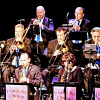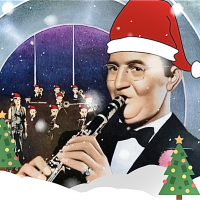Home » Jazz Musicians » Stan Kenton
Stan Kenton
Stanley Newcomb Kenton (December 15, 1911 - August 25, 1979) led a highly innovative, influential, and often controversial American jazz orchestra. In later years he was widely active as an educator.
Stan Kenton was born in Wichita, Kansas, and raised first in Colorado and then in California. He learned piano as a child, and while still a teenager toured with various bands. In June 1941 he formed his own band, which developed into one of the best-known West Coast ensembles of the Forties.
Kenton's musical aggregations were decidedly “orchestras.” Sometimes consisting of two dozen or more musicians at once, they produced an unmistakable Kenton sound--as recognizable as that of the bands of Glenn Miller, Duke Ellington, or Count Basie. So large an orchestra was able to produce a tremendous, at times overpowering, volume in the dance and concert halls of the land; among musical conservatives it developed a reputation for playing strange-sounding pieces much too loudly, and indeed one comical MC introduced Stan Kenton as “Cant Standit.”
A Kenton specialty was Afro-Cuban rhythm, as exported to North America by such bandleaders as Machito (whose brass and reed sound, in turn, began to show the influence of Kenton). Translated into the Kenton idiom, however, the Latin rhythms might be scored for a full panoply of percussion instruments: tympani, bongos, conga, timbales, claves, and maracas. This component of Kenton's work may be heard on the 1947 recording “Machito” and on the album Cuban Fire, still in print after more than fifty years of ceaseless change in popular music.
Many of Kenton's band arrangements were written by Kenton himself, as well as other composers and arrangers such as Gene Roland, Pete Rugolo, W. A. Mathieu, Johnny Richards, Lennie Niehaus, Gerry Mulligan, Hank Levy, Bill Russo, Dee Barton, Bill Holman, Shorty Rogers, Ken Hanna, and Bob Graettinger (ref. his formidable but fascinating “City of Glass”). The music, which could be intensely dissonant, made use of powerful brass sections and unconventional saxophone voicings that showed Kenton's love of experimenting, reflected in the names he gave his ensembles: “Innovations Orchestra,” “Neophonic Orchestra,” and “Mellophonium Orchestra.” Kenton's theme song from the early days to the last was called, significantly, “Artistry in Rhythm.” It was owing in part to Kenton's ambitious musical nomenclature that many critics dismissed his work as mannered and pretentious. But apart from recording a few dance-band albums (Kenton's men could play standards beautifully), he avoided compromising his idea of jazz to please either critics or public.
Read moreTags
Stan Kenton and His Orchestra: Roots

by Jack Bowers
Roots is a most appropriate title for this series of concerts by the Stan Kenton Orchestra recorded in 1944-45 on behalf of the Armed Forces Radio Service. While the sessions do include a handful of staples from the Kenton book ("Eager Beaver," “Reed Rapture," “Tampico," the well-known “Artistry in Rhythm" theme), it's clear that Kenton and the orchestra hadn't yet developed the singular persona that enabled it to safeguard its place among the front ranks of contemporary big bands until ...
Continue ReadingStan Kenton: Salute!

by Jack Bowers
Stan Kenton, one of the most renowned and influential bandleaders of the twentieth century, died on August 25, 1979. Fortunately—for the sake of history in general and creative music in particular—Kenton's remarkable legacy lives on, and in a perceptive and open-minded world would endure forever. Even to this day, small but devoted groups of enthusiasts share a wish that some previously hidden array of his material might come to light, satisfiying for the moment their craving for more memorable music ...
Continue ReadingStan Kenton and His Orchestra: Concert on the Pacific

by Jack Bowers
The Stan Kenton Orchestra's Concert on the Pacific is actually a compendium of several concerts recorded between January and March 1958 at the Rendezvous Ballroom in Balboa, California—a series that almost emptied Kenton's wallet and caused him to pause and regroup a year or so later. While this was post-Rosolino/Sims/Konitz/Levey, the Kenton Orchestra was never without its share of outstanding soloists, in this case saxophonists Lennie Niehaus, Bill Perkins, Richie Kamuca and Bill Robinson; trumpeters Sam Noto, Billy Catalano and ...
Continue ReadingStan Kenton and His Orchestra: In a Lighter Vein

by Jack Bowers
Stan Kenton was a man of many moods, as was his intrepid and popular orchestra, which endured until his passing in August 1979 and whose renown is kept alive even today by the Stan Kenton Legacy Orchestra. Kenton dons his carefree hat on In a Lighter Vein, an assortment of straight-ahead themes from the orchestra's jazz library, preserved in five concert performances from 1953-55 beneath the umbrella of NBC radio's All Star Parade of Bands. Original compositions ...
Continue ReadingStan Kenton and His Orchestra: Concert Kenton

by Jack Bowers
There's no question that Stan Kenton led one of the more successful and popular orchestras of the storied Big Band Era, winning various yearly polls while drawing large crowds to his jazz concerts and dance performances from coast to coast. But Kenton always wanted something more: to enlighten as well as entertain. Music, he felt, should be cerebral as well as visceral. And so he formed the Neophonic Orchestra to play the sort of forward-looking jazz he felt many listeners ...
Continue ReadingThe Stan Kenton Orchestra / Trinity College: Concert Impressions

by Jack Bowers
Here's another splendid two-disc anthology from Tantara Productions showcasing music from the capacious Stan Kenton library, performed on Disc 1 by the Kenton Orchestra circa 1972-76 and on Disc 2 by the Trinity College Big Band, Alumni Band and Symphony Orchestra in 2004 and 2007. Tantara has now released more than twenty albums, all devoted to music by Kenton, with several, like this one, including performances by a second ensemble, usually from a college or university. Each ...
Continue ReadingStan Kenton and His Orchestra: A Kenton Trilogy, Part 1: Dance Time

by Jack Bowers
Better late than never. Having already appraised Part 2 of Sounds of Yesteryear's three-part salute to the Stan Kenton Orchestra, it seemed only proper that the same should be done (albeit out of order) for Part 1 (and Part 3 as well, whenever it is released). Unlike Part 2, which is devoted to the artistry of four members of the orchestra (saxophonists Lee Konitz and Pepper Adams, vocalist Ann Richards, mellophonium master Ray Starling), Part 1 consists of themes from ...
Continue ReadingStan Kenton: 1950-1951

Source:
JazzWax by Marc Myers
For many fans of Stan Kenton, his New Concept of Artistry in Rhythm album (recorded in 1952) is their listening starting point. More intensive fans like to dip into his 1940s discography, which includes Eager Beaver, Tampico, Intermission Riff and Southern Scandal, allowing them to fully appreciate the evolution of Kenton's wall-of-sound approach. As for the years 1950 and 1951, they are generally ignored. [Publicity still above of Stan Kenton] The primary reason for this Kenton listening gap are three ...
read more
Stan Kenton: The Opus Story

Source:
JazzWax by Marc Myers
After Stan Kenton wrote and arranged Opus in Pastels in 1940, the song was regularly performed by his band and became a hit in 1946 after it was recorded at Capitol. With the arrival of the 12-inch album format in 1955, the song was so pouplar that Kenton commissioned arranger Gene Roland to write a series of “opus" pieces with catchy melody lines to showcase the saxophones. Even arrangers Pete Rugolo and Bob Graettinger got into the opus act. Interestingly, ...
read more
Stan Kenton: Back to Balboa

Source:
JazzWax by Marc Myers
Back in the early 1980s, I headed out to Los Angeles to visit a friend in Huntington Beach for a few days. For the summer trip—my first to the L.A. area—I packed my Sony Walkman and a bunch of West Coast jazz cassettes. The tapes weren't to entertain. My motive was more anthropological. I wanted to listen to the music in its natural habitat while walking on the beaches of Hermosa, Balboa and Santa Monica. In other words, I wanted ...
read more
Stan Kenton in Paris, 1953

Source:
JazzWax by Marc Myers
From late August to late September of 1953, Stan Kenton embarked on one of the great European tours of his career. His hard-charging New Concepts band—formed in 1952 to feature a brassy, swinging wall of sound that showcased the personalities of individual soloists—was electrifying. The musicianship of each chair in the band was hair-raising when combined with gutsy arrangements. Kenton's 20-person road band in the late summer of '53 consisted of Buddy Childers, Conte Candoli, Don Dennis, Don Smith and ...
read more
Kenton: Concerts in Miniature

Source:
JazzWax by Marc Myers
In early 1952, money was tight for Stan Kenton. The musical experiments of his massive 39-piece Innovations in Modern Music Orchestra in 1950 had taken a toll on his wallet. What's more, the music didn't go over well with audiences, who found the classically influenced arrangements largely a bore. Kenton reconfigured his band in early 1952 and commissioned arrangements by Shorty Rogers, Gerry Mulligan, Bill Holman and others. But he needed to get the word out. The NBC radio network ...
read more
Stan Kenton: Germany, 1953

Source:
JazzWax by Marc Myers
Between 1949 and 1951, Stan Kenton led a 39-piece band known as the Innovations in Modern Music Orchestra. The band's dreamy, Wagner-esque jazz arrangements were hip for a brief period but soon took on the characteristics of a wobbly truck transporting too much fine furniture. The orchestrations didn't click with young audiences and Kenton's musicians grew weary performing the syrupy modern-classical material. So in January 1952, Kenton abruptly retooled and began commissioning swinging charts by Johnny Richards, Shorty Rogers, Gerry ...
read more
"Stan Kenton: Artistry in Rhythm- Portrait of a Jazz Legend" wins two EMPixx Awards

Source:
Graham Carter
The EMPixx Awards has honored Jazzed Media with two 2011 EMPixx Awards for the documentary film Stan Kenton: Artistry in Rhythm- Portrait of a Jazz Legend. The film has received a Platinum Award in the Documentary Category and an additional Platinum Award in the Use of Music Category. The documentary film was produced and directed by multi-Grammy nominated producer and award winning filmmaker Graham Carter, founder of Jazzed Media. Jazzed Media produces jazz CDs and documentary films. Previously the Kenton ...
read more
Jazzed Media's Stan Kenton Documentary Honored with Videographer Award

Source:
Michael Bloom Media Relations
The Videographer Awards has honored Jazzed Media with a 2011 Videographer Award of Excellence for the documentary film Stan Kenton: Artistry in Rhythm- Portrait of a Jazz Legend. The documentary film was produced and directed by multi-Grammy nominated producer and award winning filmmaker Graham Carter, founder of Jazzed Media. Jazzed Media produces jazz CDs and documentary jazz films. In recognition of the upcoming 100th birthday celebration of Stan Kenton in 2011 this almost 2 hour documentary by award winning jazz ...
read more
"Stan Kenton: Artistry in Rhythm - Portrait of a Jazz Legend" Wins Telly Award

Source:
Michael Bloom Media Relations
The international Telly Awards, which recognizes excellence in the film and video industries, has honored Jazzed Media with a 2011 Telly Award- Bronze for the documentary film Stan Kenton: Artistry in Rhythm- Portrait of a Jazz Legend. The documentary film was produced and directed by multi-Grammy nominated producer and award winning filmmaker Graham Carter, founder of Jazzed Media. Jazzed Media produces jazz CDs and documentary jazz films. In recognition of the upcoming 100th birthday celebration of Stan Kenton in 2011 ...
read more
DVD: Stan Kenton - Artistry in Rhythm: Portrait of a Jazz Legend (2011)

Source:
Something Else!
Stan Kenton would have been 100 this year and, in many ways, he's as misunderstood now as he was in his own time. A comprehensive new Jazzed Media biopic from filmmaker Graham Carter, though perhaps too lengthy at 117 minutes, goes a long way toward changing that. Kenton brought to fame a series of jazz music's most recognizable names, and encouraged an intriguing combination of the genre with modern classical music—not to mention Cuban rhythms—but, ultimately, was never forgiven back ...
read more









































